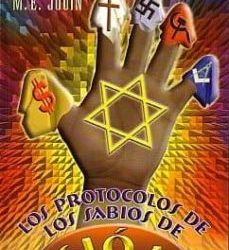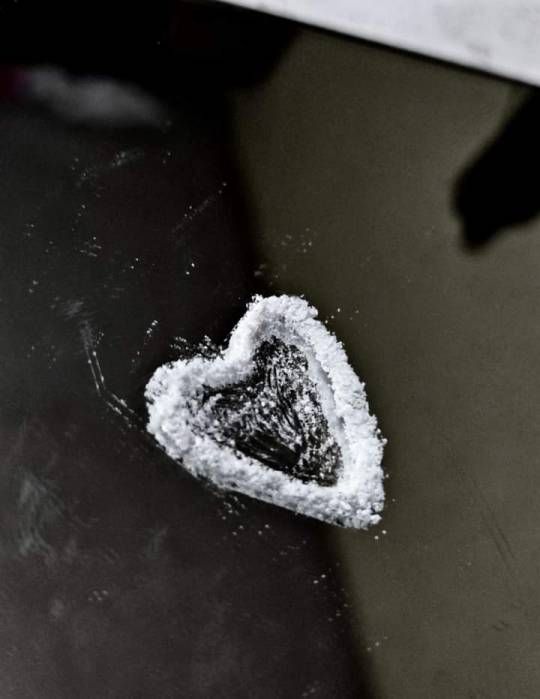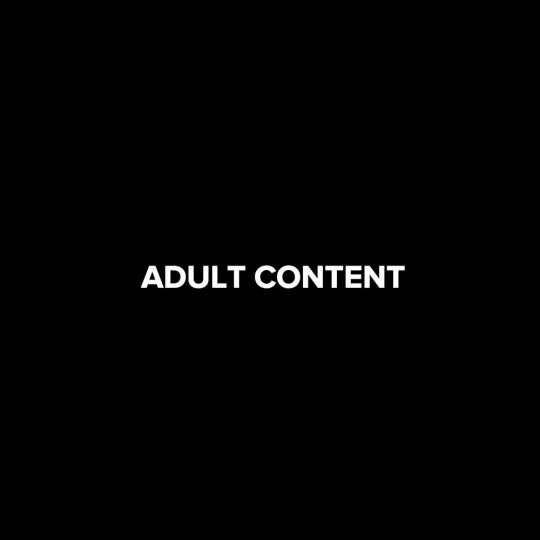#de cocaína
Text
Poema: Me llamo metanfetamina.
Destruyo hogares y fragmento familias enteras. Te quito a tus hijos, y ese será sólo el principio. Soy más brillante que un diamante, más preciado que el oro dorado. El sufrimiento que provoco es peor que la pesadilla de un loco.
Si me necesitas, soy fácil de encontrar. En cualquier ciudad, a cualquiera hora, le doy maldad a cualquiera que implora.
Vivo con los ricos. Vivo con los pobres. Vivo con tu ser más amado, tal vez en la habitación de a lado.
Soy hecho en un laboratorio, pero no el que te imaginas. Puedo ser hecho en cualquier casa, detrás de las cortinas.
En la cajuela de un coche, incluso afuera en la noche. Puedo destruir una nación, sólo usa tu imaginación.
Tengo mil nombres. Estoy segura de que has oído hablar de mí. Me llamo metanfetamina de cristal.
Mi poder es increíble, prueba y te sentirás invencible.
Prueba una vez, y tal vez te deje ir. Prueba dos veces, y da por hecho que tu alma ya me pertenece.
Una vez que te posea, vas a robar, mentir, manipular, incluso matar. Harás lo que sea necesario, sólo por una dosis más.
Los crímenes que cometerás por mí sueño narcótico no harán reír ni al más cínico cómico.
Le mentirás en la cara a tu madre, le vas a robar a tu padre. ¿Lo peor? Cuando veas sus lágrimas, ni siquiera estarás triste.
Olvidarás tus valores y cómo te criaron. Pensaré por tí, te enseñaré cómo moverte. Sigiloso en la noche, oculto de las criaturas que tu patética mente psicótica ha creado. Buscando cámaras en las paredes mientras susurras cosas sin sentido.
Le quitó sus hijos a los padres, y le quito los padres a los hijos.
Te lo voy a quitar todo. Tu amor propio, tu orgullo y tus logros. Todo por lo que has trabajado, y todo por lo que trabajarás.
Lo vas a perder todo. Tu salud, tu dinero, tu control, tu mente, tu cuerpo, tu familia. Quedarás aislado y solo.
Te voy a quitar todo hasta que ya no te quede nada por dar. Cuando finalmente termine contigo, agradece si sigues con vida.
Si me pruebas, estás advertido. Da por seguro que te voy a quitar la cordura.
Las pesadillas que te daré asustarán hasta al más frío asesino. Las voces y las sombras en la oscuridad.
Los delirios y la paranoia.
Las taquicardias, el sudor, los temblores, los ataques de pánico, las visitas a urgencias, sangrado nasal, riñones destrozados.
Todos esos son mis regalos.
Vas a tratar de dejarme. Pero a esas alturas, sabrás en lo más profundo de tu bastarda alma que ya me perteneces. Jamás volveremos a estar separados.
Te vas a arrepentir de probarme, todos los hacen. Pero no me culpes a mí. Yo no te busqué, fuiste tú a mí.
No debiste probarme. ¿Cuántas veces te advirtieron? Pero subestimaste al mismo diablo.
Sólo tenías que decir no, y seguir con tu vida. Si pudieras volver a ese día, ¿Qué responderías?
Yo seré tu amo, y tú serás mi mascota. Si quieres hasta iré a tu funeral.
Puedes probarme por diversión, pero no soy un juego.
Te voy a hacer sentir tanta miseria y dolor que las palabras jamás podrán explicar.
Vamos, toma mi mano. Déjame guiarte al infierno.
#español#adicción#pensamientos#existencialismo#frases#frases de reflexion#poesía#nihilismo#dolor#amor#drogas#metanfetamina#cristal#cocaína#triste#depresión#frases de amor#filosofía#notas#notas tristes#citas#suicido
13 notes
·
View notes
Text
Primero algo sobre mí, no es la primera vez que escribo en internet, he sido activa en foros alguna vez pero nunca en blogs así, no sé muy bien lo que saldrá de todo esto, creo que más bien será una especie de diario personal, de desahogo, contando los vivencias, pensamientos, emociones, opiniones personales (sin intentar convencer a nadie de nada porque es lo que yo he sentido y siento)... En fin contar mi historia de hace dos años y medio atrás hasta ahora sobre todo.
Y no seguiré ningún orden cronológico pues me es imposible porque no tengo nada apuntado pero si se va leyendo creo que conseguiré explicarme y hacerme entender.
Primero de todo contar algunas cosas sobre mí, algunas afectan a lo que he vivido y vivo y otras simplemente tener algunos datos, muchas me olvidaré así que seguro las iré añadiendo más adelante.
Tengo 43 años, soy madre de 3 niños que ahora mismo no tengo conmigo por razones que iré contando más adelante (se merecen una entrada ellos solos) un niño de 17 años, una niña de 12 y el último otro niño de 1 año. Divorciada hace seis años de un hombre con el que estuve 16 años, padre de mis dos primeros hijos. Mi matrimonio se rompió (así brevemente) porque me diagnosticaron una enfermedad mental "trastorno límite de personalidad", trastorno adaptativo con ansiedad, trastorno de la conducta alimentaria (bulimia) y estado de ánimo depresivo, esto en 2018.
Actualmente y desde el 2018 estoy medicada y en terapia pero caí en las drogas y consumo cocaína en base fumada, lo que se dice "patología dual' (trastorno mental + adicción). Además mi consumo es alto para llevar consumiendo solo 3 años.
Empecé esnifando y al año con la base.
Soy una adicta algo atípica, según me han dicho los terapeutas a los que he ido, porque sí, he ido varias veces a consultas y centros para dejar de consumir pero no he llegado a dar el paso final con excusas absurdas (también lo contaré más adelante), lo dicho es algo poco habitual porque solo consumo esta sustancia en gran cantidad, nunca la había consumido ni probado antes de los 40 y no consumo ninguna otra droga excepto tabaco que sabemos todos que aunque nocivo es legal y la verdad es que fumo de liar y poquito je je je.
Soy culta, me encanta leer aunque mis estudios son los básicos pero sé que soy inteligente.
He tenido 3 relaciones largas en mi vida de 7 años de 16 años (2 hijos) y esta última de 2 (1 hijo) pero entre mi ex marido y mi ex pareja he sido muy promiscua (característica bastante habitual en gente que padece TLP)
Tengo una hermana y mis padres viven pero no tengo relación hace años con niguno de los 3, estoy sola completamente refiriéndome a familia de sangre, bueno... En tema de amigos no es muy diferente, la gente tóxica no tenemos amigos de verdad.
No trabajo hace más de 19 años creo.
Soy sincera, digo muchas palabrotas al hablar, me gusta hablar de manera correcta, soy de las que busca todo el día cosas en Google, me encanta jugar a Apps de preguntas y respuestas tipo trivials, se me da mal mal cualquier cosa que tenga que ver con números, tengo buena memoria, soy cariñosa y me apasiona la mente humana y todo lo relacionado con la inteligencia emocional y la psicología.
Y yo que sé que más contar así de primeras.
Que estoy completamente destrozada por mi última relación, él narcisista de manual y yo dependiente emocional, hemos acabado él en la cárcel y yo hundida psicológicamente.
Así que os iré contando cómo hemos podido llegar a esto.
#borderline#borderline narcissist#cocaína#cronicas de un tlp#inteligencia emocional#narcisista#narcisismo#tlp#transgender
2 notes
·
View notes
Text

View on Twitter
@CNN @JUANES @carlosvives @BillClinton @AlvaroUribeVel #cocaína #EEUU @ISRAEL @netanyahu #fentanilo #ucrania , pic.twitter.com/aGys4hiYnI
https://twitter.com/InfoWARSRZK1/status/1724493998830571691/video/1 Las vidas de #palestinos desplazados de #gaza https://twitter.com/WizardSX0/status/1724469357227479511/video/1☠️@FDI pic.twitter.com/MRwZwfqdM7🇮🇱🦎 🇬🇧 🚨🇵🇸

























View on Twitter
https://www.tumblr.com/redreziztencia/727540172910133248/naason
#@CNN @JUENES @carlosvives @BillClinton @AlvaroUribeVel#cocaína#EEUU @ISRAEL @netanyahu#fentanilo#ucrania#pic.twitter.com/aGys4hiYnI#https://twitter.com/InfoWARSRZK1/status/1724493998830571691/video/1 Las vidas de#palestinos desplazados de#gaza https://twitter.com/WizardSX0/status/1724469357227479511/video/1☠️@FDI pic.twitter.com/MRwZwfqdM7🇮🇱🦎 🇬🇧 🚨🇵🇸
7 notes
·
View notes
Text
¿Que carajos?
Frene en seco y mirando a todas las direcciones, confirme que estaba perdida.
#art#escritos#dolor emocional#frases#funny#frases de amor#drogadicción#cosas que escribo#drogada#una chica escribiendo#citas tristes#citas de libros#cigarrillos#cigarette#corazon#cocaína
2 notes
·
View notes
Text
Todos esos domingos que iba a visitarte me hacian pensar en si de verdad quería que nuestra vida fuera así siempre.
Recaída tras recaída, creyendo que todo iba bien, llanto tras llanto, perdón tras perdón y ese ciclo sin fin que vivimos por 10 años. Y si, no le importaba a una parte de mi.
Te veía así, flaco y ojeroso, pálido, con la boca seca de hablar tanto, por expresar todo o casi todo lo que pasaba por tu cabeza a todos los presentes y sentía mi corazoncito chiquito, queriendo sacarte de ahí para estar viviendo algo totalmente diferente, si tanto dolor, sin tantas mentiras.
Pero entre todo lo que decías, me miraste para confesarme que habías robado ese billete aún sabiendo que era lo que quedaba después que yo lo había dado todo una vez mas. Tus razones fueron que sabías que habría más por la mañana y que sobretodo querías darme una lección. Sobre qué??? Si ahí estaba yo, otra vez contigo sin importar cómo había acabado todo la última vez... Conmigo en la que era nuestra casa, empacando nuestras cosas, con los gatos escondidos y asustados por no saber que sucedía. Perdón que lo repita tanto, pero me viene a la mente ese recuerdo con frecuencia.
La cosa es, que justo ahí, en ese momento desperté y dije nooo así no. Y me duele también recordar esa mañana que me despertaste con un beso, lo siento mucho. Las cosas tenían que cambiar.
Sin embargo eso no significa que no me pregunte casi todas las noches dónde estarás? Qué haces cuando te pierdes tantos días? Cómo estás?
Aquí estoy yo, drogándome cada día un poco más. En el trabajo, en la calle, en mi cuarto, con mi familia. Algunas cosas en mi vida han mejorado, pero sigo pensando en lo fantástico que sería irte a visitar a tu casa, un lugar construido por y para ti lejos de la mierda que te pone mal, que me invitaras a sentarme en tu mesa para degustar esa comida tan deliciosa hecha con tu manitas, con tu ingenio y tú amor. Que me contaras sobre el libro que estás leyendo y lo bien que te ha sentado ser independiente y responsable. Que me hablaras sobre tu trabajo y yo te escuchara recostada en tus piernas mientras acaricias todo mi cuerpo.
Solo quería que pudieras estar bien por ti, para ti y me invitaras a ese espacio en tu vida para compartir mejores cosas.
Hicimos todo tan rápido... Pero que más da! Si solo son pensamientos que invaden mi cabeza mientras estoy drogada en el trabajo llorando y escuchando esas canciones que tanto te gustaban poner en casa y yo aborrecía porque sentía que me cantabas tu despedida.
Perdóname, perdón por lo mucho que te lastimé también. Quisiera escribir más pero mi garganta tiene un nudo que no me deja ni respirar.
Una línea para pensar en ti, la otra para olvidarte.

#textos en español#text post#tristeza#acid trip insane#soledad#dolor#acid trip#textos#drogas#ayuda#noches frías#cocaína#te extraño pero ya que mierda#noches de letras#letras tristes
4 notes
·
View notes
Text

Una pijamada tranqui
2 notes
·
View notes
Text
El Gobierno nacional inicia la venta de bienes decomisados en causas de corrupción y narcotráfico
#Judiciales #Poítica | El Gobierno nacional inicia la venta de bienes decomisados en causas de corrupción y narcotráfico
El Gobierno argentino, a través de la #AABE, inicia la venta de #inmueblesdecomisados en casos de #corrupción, narcotráfico y #tratadepresonas, transformando activos ilícitos en recursos para la sociedad.
El Gobierno argentino, a través de la AABE, inicia la venta de inmuebles decomisados en resonantes casos de corrupción y narcotráfico, transformando activos ilícitos en recursos para la sociedad.
El Gobierno nacional, a través de la Agencia de Administración de Bienes del Estado (AABE), ha comenzado el proceso de venta de cinco inmuebles decomisados en resonantes casos de corrupción,…
#AABE#activos incautados#Agencia de Administración de Bienes del Estado#Bajo Flores#bienes incautados#Carbón Blanco#Carlos Salvatore#Clan Aliaga#cocaína#corrupción#Crimen Organizado#Cristina Kirchner#cuadernos#Daniel Muñoz#inmuebles#inmuebles decomisados#justicia#lavado de dinero#Marcela Losardo#Martín Cosentino#narcotráfico#Néstor Kirchner#talleres clandestinos#transparencia#trata de personas
0 notes
Text
El Gobierno nacional inicia la venta de bienes decomisados en causas de corrupción y narcotráfico
#Judiciales #Poítica | El Gobierno nacional inicia la venta de bienes decomisados en causas de corrupción y narcotráfico
El Gobierno argentino, a través de la #AABE, inicia la venta de #inmueblesdecomisados en casos de #corrupción, narcotráfico y #tratadepresonas, transformando activos ilícitos en recursos para la sociedad.
El Gobierno argentino, a través de la AABE, inicia la venta de inmuebles decomisados en resonantes casos de corrupción y narcotráfico, transformando activos ilícitos en recursos para la sociedad.
El Gobierno nacional, a través de la Agencia de Administración de Bienes del Estado (AABE), ha comenzado el proceso de venta de cinco inmuebles decomisados en resonantes casos de corrupción,…
#AABE#activos incautados#Agencia de Administración de Bienes del Estado#Bajo Flores#bienes incautados#Carbón Blanco#Carlos Salvatore#Clan Aliaga#cocaína#corrupción#Crimen Organizado#Cristina Kirchner#cuadernos#Daniel Muñoz#inmuebles#inmuebles decomisados#justicia#lavado de dinero#Marcela Losardo#Martín Cosentino#narcotráfico#Néstor Kirchner#talleres clandestinos#transparencia#trata de personas
0 notes
Text
Peruanos foram presos em Porto Velho com 23 kg de cocaína
Droga estava acondicionada na bagagem dos dois peruanos que viajavam num táxi; produto estava na fase do cloridrato
Nesta terça-feira (18), a Superintendência da Polícia Rodoviária Federal (PRF) Rondônia, anunciou ter apreendido, na noite do último sábado (15), na BR-364, próximo ao km 769, município de Porto Velho, uma carga de cloridrato de cocaína que era transportada por dois criminosos de…

View On WordPress
#23 kg de cocaína#CAPITAL DA TILÁPIA NEWS.#DESTAQUE 2#famosos#foram#noticias#ocombatente#ocombatente.com#Peruanos#porto velho#Presos
0 notes
Text
Policía de Control de Drogas decomisa 20 paquetes de cocaína en APM Terminals
CR Informativa | [email protected]
En un contundente golpe al narcotráfico, la Policía de Control de Drogas (PCD) ha decomisado 20 paquetes de cocaína, cada uno pesando aproximadamente 1 kilo, en el Muelle de APM Terminals en Moín de Limón. La operación se llevó a cabo este sábado como parte de las labores de inspección y perfilamiento en el marco de la Operación Soberanía.
El…

View On WordPress
#APM Terminals#CR Informativa#decomiso de cocaína#Lucha contra el narcotráfico#Operación Soberanía#Seguridad Públcia
0 notes
Text

- —Entonces, ¿estas lista para ir a esta fiesta, aburrirnos a la mitad de ella y fumar marihuana en un baño de una casa desconocida? — -todo el mundo pensaría que era hasta masoquista lo que decía, porque era predecible en donde acabarían, pero era un rasgo de su amistad.
#* ⠀ 🍒 ⠀ ╱ ⠀ dialogue ⠀ 、 ⠀ ❪ ⠀ kim wonshik ⠀ ❫#* ⠀ 🍒 ⠀ ╱ ⠀ dynamic ⠀ 、 ⠀ ❪ ⠀ wonshik & minju ⠀ ❫#smileflowcr#hola :)#tu incordio favorito está de regreso con un starter que no me pediste#pero no puedo dejar de pensar en la cocaína y las claviculasDIGO#s*
5 notes
·
View notes
Text
PF apreende 420 kg de cocaína na Rodovia Castelo Branco/SP Com apoio da PM, a ação ocorreu após a abordagem de um caminhão vindo do Mato Grosso do Sul.
São Paulo/SP. A Polícia Federal apreendeu, na manhã desta quinta-feira (02/05), em conjunto com o TOR (Tático Ostensivo Rodoviário) aproximadamente 420kg de cocaína. A ação ocorreu após a abordagem de um caminhão vindo do Mato Grosso do Sul, na Rodovia Castelo Branco/SP, sentido capital.
Policiais federais e policiais militares da TOR realizaram a vistoria no veículo, onde encontraram, em…

View On WordPress
0 notes
Text
Gánsters de los Balcanes: ‘Reyes narcos’ del tráfico de cocaína en Europa
Los capos narcos serbios-albaneses-belgas del cártel de los Balcanes, dominan la distribución de droga en Europa, cooptaron soldaditos en los suburbios, e incluso desplazaron a las bandas latinoamericanas.
Slobodan Kostovski, narcotráfico y el cártel de los Balcanes
La creencia popular considera que el tráfico de drogas es una epidemia exclusiva de Latinoamérica, sobre todo con los nombres de…

View On WordPress
#‘Reyes narcos’#Gánsters de los Balcanes#Los capos narcos serbios-albaneses-belgas#Tráfico de cocaína en Europa#Urgente 24
0 notes
Text
@inforzk @BBC tumblr.com/redreziztencia/733986457992167424/carlosvives-st%C3%A1-en-la-lista-billclinton-d%C3%B3nde?source=share .
@CNN @JUENES @carlosvives @BillClinton @AlvaroUribeVel #cocaína #EEUU @ISRAEL @netanyahu #fentanilo #ucrania , pic.twitter.com/aGys4hiYnI
https://twitter.com/InfoWARSRZK1/status/1724493998830571691/video/1 Las vidas de #palestinos desplazados de #gaza https://twitter.com/WizardSX0/status/1724469357227479511/video/1☠️@FDI pic.twitter.com/MRwZwfqdM7🇮🇱🦎 🇬🇧 🚨🇵🇸

View on Twitter
https://www.tumblr.com/redreziztencia/733986457992167424/carlosvives-st%C3%A1-en-la-lista-billclinton-d%C3%B3nde
#@inforzk @BBC tumblr.com/redreziztencia/733986457992167424/carlosvives-st%C3%A1-en-la-lista-billclinton-d%C3%B3nde?source=share .#@CNN @JUENES @carlosvives @BillClinton @AlvaroUribeVel#cocaína#EEUU @ISRAEL @netanyahu#fentanilo#ucrania#pic.twitter.com/aGys4hiYnI#https://twitter.com/InfoWARSRZK1/status/1724493998830571691/video/1 Las vidas de#palestinos desplazados de#gaza https://twitter.com/WizardSX0/status/1724469357227479511/video/1☠️@FDI pic.twitter.com/MRwZwfqdM7🇮🇱🦎 🇬🇧 🚨🇵🇸#matador 🇪🇭#@Matador000 https://pic.twitter.com/sN9jRx9GO#@carlosvives#este mensaje es para ti.#Mira al niño de la foto#observa bien a la médica que lo atiende#que impotente no puede dejar de llorar.#Esa bandera que ondeas con orgullo es la responsable del genocidio de niños inocentes en Gaza#incluso bombardea hospitales donde hay niños como el de la foto.#Hoy le darás las buenas noches a tus hijos y no estarás buscándolos debajo de los escombros como miles de papás palestinos.#Eso era todo.#Traducido del español por#este mensaje es para ti. https://pic.twitter.com/sN9jRx9GO#Miren al niño de la foto#fíjense bien en el médico que lo atiende#que impotente no puede parar de llorar.#Hoy les darás las buenas noches a tus hijos y no los buscarás bajo los escombros como miles de padres palestinos.#Eso fue todo.#@BBC @CNN @JUENES @carlosvives está en la lista🇺🇸 @BillClinton dónde aparece con el Nro#89 y @AlvaroUribeVel con el Nro
4 notes
·
View notes
Text
Nunca lo acepto, pero una parte de mi se aferró a ti y a los recuerdos
Lo siento, nunca podré olvidarte.
#i love you#yo antes de ti#thank you#escritos#chica tumblr#te odio#te amo#text#text post#dolor emocional#frases#art#drogadicción#funny#frases de amor#cosas que escribo#una chica escribiendo#drogada#citas de libros#citas de amor#citas#cigarrillos#cocaine#cocaína#drogadicto#drogas#i am alone#amor#poemas de amor#amor propio
3 notes
·
View notes
Text


the cultural heritage of mankind
As long as humans have populated this planet, drugs of various kinds have been used. Cultural history bears witness to this in many places: Mead and beer, hemp and opium, peyote and mescaline, tobacco, myrrh, frankincense, coffee, tea, betel, khat, herb or coca leaves - to name but a few - have fascinated people ever since they have been attached to some concept of pleasure. Sometimes drugs are a sacred medium of religious awakening, sometimes a means of a carnivalesque revaluation of all values. Sometimes they provide a collective ecstatic sense of purpose, sometimes they serve to make the hardships of everyday life more bearable: substances that do more than satisfy hunger and dispel thirst are firmly embedded in the cultural heritage of mankind.
Today, however, this diversity of means and motives for consumption is often minimised and instead a link between drug use and danger is suggested. The political problematisation of psychotropic substances began in the early modern period: at the beginning of the 17th century, the Ottoman Sultan Murad IV found it intolerable that tobacco and coffee houses had not only become places of consumption, but also centres of public discussion and thus places of criticism and opposition. He therefore had all tobacco houses torn down in 1633 and made smoking tobacco punishable by death. He used modern methods in the manhunt, such as undercover investigations and bogus purchases. The assets of those executed went to the sultan. Obviously, it was less about the drug itself; rather, the smoking ban fulfilled several useful functions: The criminalisation of a behaviour that was widespread on a mass scale and a sanction as part of - or under the guise of - drug control.
Until the 19th century, however, bans on drinking or smoking were rare. Since then, however, drugs and danger have become ever more closely linked, for example by the idea that all drugs inevitably lead to addiction and thus to ruin. Whenever there is talk of drugs or even "narcotics", the danger does not seem far away. The scientifically untenable but long-lasting talk of gateway drugs is proof of this - in fact, there is no reliable empirical evidence to show that the use of one drug often leads to another and thus deeper into the drug problem. Anyone who argues in this way has the slippery slope in mind, the fall that - for all those who have started - can only be avoided with great effort or not at all. Drug education in schools may have taken new, sensible paths at times. However, the actual and urgent reason for its necessity usually remains central: the danger.
However, the history of drug use is diverse and its widespread practices are only mediated, sequential or partially related to addiction and social decline. In addition, whenever people fall out of the social order, drugs were at worst a catalyst, but rarely or never the actual cause. The reluctant reference to drugs as the cause of social imbalances therefore has more the character of a handy and long-practised diversionary manoeuvre: those who hold drugs responsible do not have to talk about structural social imbalances.
It may therefore be time to turn our gaze round and look at the many and wide-ranging motives for drug use. After all, the matter of drugs is a kind of never-ending story, despite all the crusades and horrendous efforts in the so-called war on drugs. The following lines bring together - without claiming to be exhaustive, of course - a number of different reasons why people take or have taken drugs. In the process, a kaleidoscope of different episodes unfolds, the collection of which alone could illustrate how abbreviated the direct link between drugs, addiction and danger is in its contemporary form. Viewed from this perspective, i.e. detached from the overlapping perception of the problem, a different connection or at least an initial suspicion may emerge: which drugs are fashionable and how states and societies deal with them could be an expression of the respective social conditions.
Of course, this is not to say that drugs cannot tear chasms, that certain patterns of consumption sometimes lead to habits and damage health in the medium to long term. However, this is only one way among many, only one possible pattern, which also has to do with the constant social and economic marginalisation and political repression of youth cultures. The drug is only one factor. However, the almost exclusive focus on the practice of addiction and the social figure of the junkie has brought the whole subject of drugs and intoxication into disrepute and led to a sometimes bizarre practice of prohibition.
For the good!
The illustrious journey through the thicket of different reasons for drug use has countless possible beginnings and stops. The following passages of intoxicated transgression are not representative of anything, they merely show that different interpretations are possible. An arbitrary but interesting starting point is provided by a circular from the Faculty of Theology in Paris from 1444, which from today's perspective provides an irritating motivation for occasional but copious drinking. It states that "folly" is man's innate "second nature" and that "wine barrels burst if you don't open the lid from time to time and let air in. We, human beings, are poorly made wine barrels that burst from the wine of wisdom if it is left in uninterrupted fermentation of devotion and the fear of God. Therefore, on certain days we allow the folly (foolishness) in us to return to worship with all the greater fervour afterwards. "To resolve the footnote[2]
The regular drinking bouts were therefore doubly necessary: On the one hand, they were in keeping with human nature and, on the other, they were essential in order to live in a godly manner and pursue wisdom. The drunken feast, which thwarted all contemplation and fear of God, was thus part of the religious order. The culturally significant tradition of the festival, i.e. a "time between the times", has its last offshoots in today's carnival. However, there is little to suggest that much remains of the radical nature of the revaluation, of the character of the substantial time-out.
Just over a century later, the court marshal Hans von Schweinichen, whose diary entries have survived, was probably similarly drunk, albeit for completely different reasons. He was also fond of the "Tears of God" (Lacrimae Christi). He was so drunk that he "slept for two nights and two days in a row that people thought I would die". However, this did not cause him to turn away from wine. Quite the opposite: "And since then I have learnt to drink wine and have continued to do so to such an extent that I might well say it would be impossible for anyone to drink me full. But whether it brings me bliss and health, I leave to his place."
Of course, we can only speculate about Schweinichen's motives. It hardly sounds like a necessity of nature, a ritualised festivity or even a condition for religious wisdom. Rather, a kind of sporting competition without deeper meaning dominates, as is still often the case today.
Without any harm
While von Schweinichen described a social structure that apparently demanded his adaptation to alcohol, similar processes have also been passed down with regard to health aspects. Zedler's Universal Lexicon, for example, a kind of 18th century storehouse of knowledge, revealed that "opium can be used in fairly large quantities without any harm and with great benefit". It is well known that opium users "cannot refrain from it", i.e. that they cannot stop using it and, according to modern diction, become addicted. However, this is not a problem, just the opposite: "For if one is accustomed to poisonous things for a long time, they do no harm to nature. "5 The purpose of consuming opium here is to develop a habit in order to henceforth be able to enjoy the medical and psychological benefits of the substance without harm. Modern addiction research is no doubt throwing up its hands in horror. However, from a medical point of view, it is also known that opiates, appropriately dosed and consumed cleanly, trigger what we today call addiction, but cause hardly any physiological or psychological damage, provided that the social life around them functions.
At this point, however, the boundary between medication and drug becomes blurred. Strictly speaking, this boundary is only outlined either way on the basis of different consumption motives. Almost all drugs were or are also medicines - so it depends on the area of use and the reason for taking them. Opiates, for example, which include heroin, have been important substances in medicine for a very long time and still are today.
A letter to the editor that an elderly woman sent to the specialist journal "The Chemist and Druggist" in 1888 also shows how historically different the motives, practices and their categorisation as a (drug) problem are. It reads: "I have used morphine regularly for 30 years. (...) This medicine, so injurious in most cases, has done no harm whatever to my vitality. Nor has it in any degree reduced my vigour, which is very similar to that of young women, although I am now 67 years old. My zest for life is excellent, I am neither as emaciated nor as emaciated as most others who have undergone this treatment. (...) The only problem that probably stems from this medicine is that I am constantly putting on body fat. I would be extremely grateful if one of your experts would be so kind as to inform me whether my increase in adipose tissue is a natural consequence of morphine consumption. "
For medical reasons, the author of these lines had fallen into an opium habit that today would be labelled a severe addiction. At the same time, there are indications that the image of the typical addict ("neither as emaciated nor emaciated as most others") was (and is) more of a media spectre than a real experience or observation. What the woman is referring to is ultimately unclear. But the debate on addiction that emerged at the end of the 19th century was fuelled by stereotypes and exaggerated figures that correspond pretty much exactly to the typical image of the woman as a junkie. And finally, if there is an undisputed connection between the effects of opiates, then it is that they curb the appetite and can hardly be responsible for obese tendencies.
The letter to the editor shows two things quite vividly: on the one hand, it is recognisable how a modern addiction narrative creeps in and begins to re-evaluate things. The author was still very much a part of Victorian England, which had few reservations about opium. At the same time, however, she was already aware of the new era of rampant problematisation of drugs - if only to distance herself from it. On the other hand, the source also shows that debates on addiction, with their typical generalisation and focus on the compulsive nature of consumption, are to a certain extent blind to the motives, or at least less receptive to them. The same consumption practice, i.e. regular and high doses, can have many different reasons.
Between enlightenment and rebellion
A different spectrum of motives for drug use unfolds around attempts to help enlightenment with psychotropic substances. While the medieval circulars emphasised that wine-fuelled folly only provided the balance to strive for wisdom at all other times, the direct link between drugs and knowledge has a long history. The ancient Greek symposion (Latin: symposium) stands for social drinking in company, resulting in profound and perhaps philosophical conversations that lead to knowledge. The term has survived in the world of science, even if today's editions tend to shine with sobriety. The fact that there are always "symposia" on alcohol addiction is probably an unintentional punchline.
Newer versions of the link between drug and cognition focus less on social situations and more on individual experiences. To a large extent, we have the Romantic conquest of drugs in the first half of the 19th century to thank for this. Thomas De Quincey, for example - one of the first modern writers to deal with the insights and abysses of the effects of intoxication in literature - spoke in the mid-19th century of memory as a "palimpsest", i.e. a rewritable parchment that still bears all the older traces. Opium exposes these traces and therefore allows deep, otherwise hidden memories: "Life had spread a shroud of oblivion over every detail of experience. And now, on a silent command, on a rocket signal that our brain releases, this shroud is abruptly removed and the whole theatre lies bare to its depths before our eyes. This was the greatest mystery. And it is a mystery that excludes doubt - for to the martyrs of opium it repeats itself, it repeats itself ten thousand times in intoxication.
Since then, there have been many variations of profound, comprehensive, absolute, paradisiacal and constantly world-shaking insights in intoxication. The writer Charles Baudelaire stepped completely out of a purely subjective position and became a pipe smoker, only to subsequently become acquainted with the false paradise. His colleague Fitz Hugh Ludlow could "look into himself and, thanks to this appalling ability, perceive very vividly and clearly all the processes of life that take place unconsciously in the normal state". The philosopher William James did not experience his childhood as De Quincey did, but he experienced the truth quite directly: "For me, as for every other person I have heard of, the fundamental of the experience [of intoxication] consists in the tremendously thrilling sensation of a haunting metaphysical illumination." On nitrous oxide, "all the logical relations of being" were revealed.
The journey continues via the philosopher of life Ludwig Klages, who, intoxicated, experiences eternity in an instant, to the philosopher Walter Benjamin, who turns the tables differently - and more cleverly than the others - and recognises the emptiness or absence of truth in intoxication, via the writer Carlos Castaneda and on to the self-proclaimed leader of the psychedelic movement of the 1960s, Timothy Leary, who wanted to give LSD to as many people as possible. The motive for drug use is always the realisation, the hope of unravelling the mystery of life, the world or even the universe once and for all. Cultural history is full of attempts to enter into a Faustian pact with the devil in order to finally understand.
Sometimes realisation should be followed by action. Some who had seen or believed they had seen "the truth" wanted to use it in a revolutionary way and kiss a different society awake with the help of fabrics. Leary, for example, was of the opinion that the cybernetic-biological evidence, i.e. the unmediated truth of DNA, which LSD supposedly inevitably and undeniably calls to consciousness, must inevitably lead to people shedding the ridiculous mask called subject and inevitably overcoming capitalism. "Turn on, tune in, drop out" was the corresponding motto of the psychedelic revolution - which, however, failed to materialise. And the poet Allen Ginsberg, a Beat - i.e. hipster - of the first hour, declared to his Beat colleague Jack Kerouac on the phone: "I'm high and naked, and I'm the king of the universe", in order to then want to instigate the psychedelic revolution.
The drunken rebellion was not always preceded by total realisation. Sometimes drug use was and is a more or less rebellious rejection of the norms of society, of the status quo, combined with an attempt to expand the scope of freedom, even without a deeper layer. The writer William S. Burroughs and the aforementioned Beats, for example, used drugs as a provocation, as an antithesis and a means of breaking out of the puritanical straitjacket of the homophobic McCarthy era of the 1950s. And after the intoxicated euphoria of the 1960s, the motif of enlightenment faded into the background anyway. Punk became the new antithesis: a rebellion without revolution - but with drugs. Drug consumption can therefore also be motivated simply by the desire to set oneself apart from one's parents' generation and to emphasise one's own "No!" to the boredom of bourgeois life with a thick bag. Even the rave and techno movement of the 1990s had such elements of rebellion, if only because older generations didn't want to understand what this "endlessly booming music" was all about. Once again, a youth culture was spreading that wanted to cheat its parents and be different, including drug use.
Optimise yourselves!
Intoxicated realisations were booming - at present they have tended to retreat into scattered esoteric circles. And since the "new spirit of capitalism" has made rebellion the mode of accumulation, i.e. the creative class the driving force of capital, it is no longer so easy to drive parents up the wall with drug consumption. Instead, a whole spectrum of adapted consumption motives has become established; optimisation is the new trend.
In late modernity, a different place or rather a different, functional contour emerged for drug use, which nevertheless remained controversial. Since the 1990s, "avant-garde perspectives have been developing that deal with completely new types and dynamics of controlled pleasure production and functional enjoyment". In keeping with the neoliberal zeitgeist, in the context of which the individual and sometimes their intoxication became a resource, a pragmatic and purpose-orientated use of drugs shines through. As a result, consumption motives are also shifting. Drugs, which as alcohol, coffee, cigarettes or medicines are an everyday part of society, could - so the faint hope - be de-ideologised. This is primarily fuelled by the aforementioned "spirit of capitalism", which elevates flexibility and creativity to the highest economic good. The distinction between medicine and drug is becoming completely fragile, and the motives for consumption are becoming as diverse as they are customised with the new commodity form of the drug. In the foreseeable future, the flexibility of the norms will move drug consumption and intoxication out of the patterns of deviant behaviour and into a space of flexible normality. The flexible person has to learn new rules for dealing with themselves and the world and, not least, in dealing with their self-control: they only have to be careful to maintain a "reflexive distance".
Subject, substance, society
The multifaceted picture of motives or reasons for drug use presented here is truly incomplete. Other topics include Drugs for the purpose of martial disinhibition - such as Pervitin, a metamphetamine that was used en masse by Wehrmacht soldiers during the Second World War to reduce feelings of anxiety and increase performance - drugs to suppress socio-psychological baggage, drugs to speed up in order to keep up with the pace of the present and the beat, or drugs to combat the boredom of dull everyday life. On closer inspection, the different categories become blurred: Leisure and work, controlled consumption and addiction, hard and soft drugs or medication and drug. None of these pairs remains a real contradiction in the long term.
The triangle of subject, substance and society, with the help of which the Swiss historian Jakob Tanner attempts to capture the history of knowledge of the concept of addiction in the 20th century and free it from the clutches of medical self-certainty, also contributes to the dissolution. when it comes to the motives for drug consumption and its analysis. Subjective dispositions and constellations are always involved, as are the stimuli of the drug. Society always plays a decisive role, even if there is less talk of it at present, and on several levels: What is the legal status and moral connotation of drugs at what time? Are opiates regarded as a household remedy for free disposal or as the stuff of hell that inevitably leads to addiction and a crash? Or does drug use fall into the clutches of political aspirations or even movements? Is it labelled as rebellious, or does it have the reputation of holding irrefutable and earth-shattering truths? Is smoking weed a good way to start an adolescent row with the parents, or do the parents themselves like to grab a bag?
There is no doubt that motives are often mixed, and the reality of drug use makes it almost impossible to decipher things clearly. And often enough, users themselves don't know exactly why they take what. And yet it should have become clear that the link between drugs, danger and addiction does not stand up to historical scrutiny. The strong focus on the problem of drugs sometimes leaves the impression of a diversionary or evasive manoeuvre. From time to time, drugs did become dangerous to the general order, for example in the context of the counterculture of the 1960s. In each case, this led to a frenzy of lurid anti-drug propaganda, which pushed the dangers to the fore with all its might and had no inhibitions about spreading lies (for example regarding alleged chromosomal damage caused by LSD).
A kind of phenomenology of different motives and practices is therefore an important thing. Especially when the role of society in the triangle of subject and substance is taken into account. The whole subject area of drugs and drug use could ultimately serve as a kind of seismograph for different social conditions. According to a somewhat hackneyed saying, every society has the fashionable drug it deserves. This perspective could provide a whole panorama of interpretations. While the usual focus is on the influence of drugs on society (for example: "What does crystal meth do to people?"), it would be interesting to ask what influence society has on drugs, i.e. which drugs are used when, for what purpose and for what social or political reasons. The much-discussed opioid crisis in the USA might then appear to be an expression of a violently depressing time that is better tolerated with sedatives. Fast coke for top performance or weed for more creativity are then no longer the drugs of choice, but rather the painkilling opioid oxycodone or the anxiety-reducing benzodiazepine Xanax to endure the madness of late capitalism or at least the pains of transformation of a society in transition that can be felt everywhere.
Intoxicated by history
For thousands of years, humans have relied on the intoxicating effects of nature: a brief history of herbal drugs
Arno Frank
Prehistory: mushrooms in the desert
The history of plant-based drugs is almost as old as mankind. Their earliest depiction dates back to a time when even the Sahara was still a flourishing Garden of Eden and can be found in a sandstone mountain range in southern Algeria. There, prehistoric cave paintings show people with ritual headdresses dancing happily. They are holding mushrooms in their hands, from which dotted lines lead to the head - not only the oldest depiction of a drug ever, but also an artistic realisation of its effects. 10,000 years old and refer to the use of psilocybin-containing mushrooms in early advanced civilisations. The psilocyn or psilocybin they contain has a similar mind-expanding effect to LSD. It leads to a change in the state of consciousness, to waking dreams and visions, but can also cause mental disorders. Among the Aztecs, the mushrooms were known as "Teonanacatl", "flesh of the gods". The oldest surviving word for drug is also of divine origin, first written down in Sanskrit in the oldest religious texts of ancient India, the Vedas. It speaks of "soma" - at once god, plant and intoxicating juice. Scientists still puzzle over the composition of this juice to this day. It is assumed that the basis was the fly agaric.
Early times: liquid bread for the pharaoh
The mushroom went out of fashion when the first civilisations cultivated agriculture. As a result, they almost inevitably discovered alcohol, almost simultaneously in the Middle East and East Asia. The oldest recipe is Chinese, but there is also evidence of breweries in Mesopotamia and Sudan. In Egyptian mythology, it was Osiris who taught people how to brew. Although there wasn't much to teach. Barley mash, stored in a damp place, begins to ferment. The wages of the labourers on the pyramids included not only bread, but also beer. Because of its effects, beer quickly became the subject of both draconian prohibitions and festive rituals. Anyone caught drinking beer among the Sumerians could be drowned in their barrels, and on high Egyptian holidays, getting drunk together was a social event. Anyone conceived during these excesses was considered a lucky child. The Greeks were more inclined towards fermenting grapes and even had a god in Dionysus who was responsible for states of intoxication. But even in Athens, alcohol served higher purposes. In the "Symposium", people drank, but also practised philosophy with their loosened tongues.
The Middle Ages:
Good humour with the herb witchIn dark times, it was very useful to know what "an herb had grown against" - and where you could find it. Little helpers grew by the wayside, from belladonna to "fool's mushrooms" and datura. In the wrong hands, they could cause a lot of mischief. In skilful hands, the soothing substances were used for healing. A mixture of mandrake, henbane and poppy was commonly used as a "sleeping sponge" for anaesthesia. In the Middle Ages, a powerful drug was extracted from the scarified seed capsules of the poppy: opium. The juice had a healing effect, as Hildegard von Bingen noted: "And this is what you heal with." As a thickened paste with honey (called latwerge), the opium poppy was used for anaesthetic purposes and was often used under the suspicious eye of the church, which considered illness to be a punishment from God. Anyone who knew too much could quickly end up at the stake as a "herbal witch".
Early modern times: leaves for the conquerors
The leaves of the coca bush have always been chewed in South America. They helped against hunger, tiredness, cold and helped the blood to absorb oxygen. A property that also helped the coca bush to enjoy a flourishing career in the Andes. Coca was also drunk as tea and always chewed with the addition of lime or plant ash. When applied with saliva, it even had a pain-relieving effect and the arrival of the Spanish conquistadors was the first turning point. It is known that many of them not only took a liking to gold, silver and tobacco, but also conquered their new empires with coca leaves in their saddle and cheek pouches. The effects of the coca plant helped the exploiters in their plunder. As early as the 16th century, a royal accountant in Peru rejoiced: "The Indians in the mines can stay 36 hours a day without sleeping or eating." Later, the stimulant even made it into the original recipe for a world-famous US lemonade, and a second turning point was the successful isolation of cocaine from coca leaves in 1859. But that's another story and has little to do with the plant.
Today: Marijuana for the masses
Cannabis, also known as marijuana, grass, weed, pot or ganja, is something of a classic in the garden of speciality plants. Cannabis was used for medicinal or spiritual purposes in ancient China and India. Although hemp was cultivated in the West, the active ingredient - tetrahydrocannabinol, or THC for short - was not valued for a long time. In Christian tradition, it was considered exotic and dangerous. Crusaders feared the assassins of the Syrian Assassins, "hash machines", which translates as "hashish people" - the Assassins allegedly used the drug to make their followers compliant. Which is probably a legend. The consumption of weed makes most people listless. Cannabis first made a career in the West in Paris in the exclusive "club of hashish eaters". Artists and intellectuals from Victor Hugo to Charles Baudelaire and the painter Eugène Delacroix met to consume "hashish" processed into a paste with cinnamon, cloves, pistachios and butter. Their aim was to expand consciousness and heighten sensory impressions - all motives that still tempt people to smoke weed today.
Cannabis is banned in most countries, while in others a rethink is underway that is not only enabling the legalisation of cannabis (for example in the USA or Uruguay), but is also bringing the medicinal benefits of the plant into focus. THC-free CBD drops have been freely available in Germany for some time now. Their active ingredient, cannabidiol, is also relaxing - but not intoxicating.
#CC BY-NC-ND 3.0 DE#drogs#CC-BY-NC-ND-4.0-DE#Arno Frank#robert feustel#freedom of expression#human history#mod studio#reality#the cultural heritage of mankind#culture#politics#equality#freedom#headdog#artwork#Complete nonsense who can read has a clear advantage#alcohol#cocaína#weed#and on and on and on#read more
1 note
·
View note